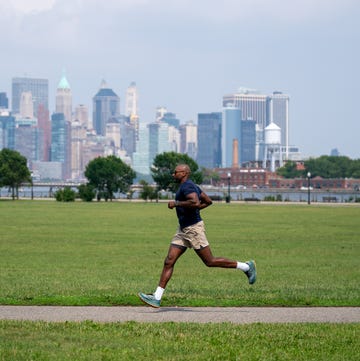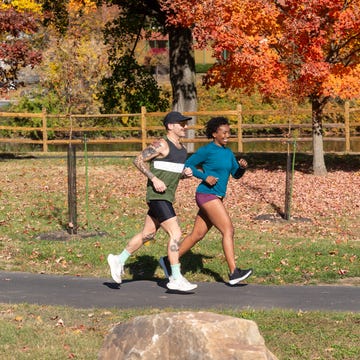Runners expect and deal with a lot of issues—knee pain, fatigue, blisters, suddenly needing a bathroom (to name a few)—but ear pain in the cold? Who knew?
It turns out that many runners take off for a run in the brisk air only to have their ears hurt when they run in the cold.
Here, experts explain why that might happen and whether it’s dangerous to feel ear pain when you’re outside. Hint: It’s likely you just need to invest in a running hat or headband—and who doesn’t love to shop for more running gear?
Why Your Ears Hurt When You Run in the Cold
There are a few reasons your ears are a hotspot for cold-related pain. “The ears are mostly made up of cartilage, so they have less fat and muscle tissue to keep heat insulated,” Chirag Panchal, DO, a physician associate with Orlando Health Longwood in Florida tells Runner’s World. When you’re exposed to colder temperatures, your ears are more vulnerable, leading to greater symptoms of pain.
“Also, when we’re running or doing activities outdoors in the cold, there’s a vasoconstriction effect of the blood flow that can impact these areas even more,” Panchal adds. In other words, in the cold, your body shunts blood away from your ears—and fingers, toes, and tip of the nose—to central areas that support vital organs. This makes these body parts colder than others and for some people, that lack of warmth leads to pain.
But it’s not just the tips of your ear that can feel cold-relate pain: The inner parts of the ears are also prone to aches. “There are a lot of small nerve endings that live in the ear canal and middle ear, which can be hypersensitive when exposed to cold temperatures,” Michael Yong, M.D., M.P.H., a board-certified otolaryngologist and neurorhinologist at Pacific Neuroscience Institute in Santa Monica, California tells Runner’s World.
In addition, many people breathe through their mouths when running. And when you breathe cold air into your mouth, it bypasses the humidification and warming functions of the nasal passages. “When this happens, the nerves lining the inside of the throat can also be irritated,” Yong says. “These nerves have an overlapping connection with the nerves in the ear, causing something we call ‘referred pain’ to the ears.”
When to Worry About Your Ears Hurting When You Run
Ear pain when running isn’t usually cause for concern—unless it’s accompanied by other symptoms, such as difficulty swallowing, hearing loss, or fluid discharge coming from the ears. These may be signs of a throat or ear infection, Yong says. If you have these symptoms, head to a doctor.
You may also want to see a professional if the ear pain lingers after you’ve returned from your run or you notice changes in skin color or texture even after warming up. This suggests the cold air may have done some damage à la frostbite.
It’s normal for the skin on sensitive spots like the ears, fingers, toes, and nose to turn white when exposed to cold. Think of how your fingertips look after reaching into a freezer in the frozen foods aisle at the grocery store. “They go from well-perfused with blood to almost white,” Panchal says. This discoloration happens when the blood vessels constrict in response to cold temperatures.
“If you’ve got pain and discoloration at your fingertips, ears, or nose, and you’re trying to warm yourself back up and it’s not going away, that would be a red flag or warning sign to seek care,” Panchal says.
How to Protect Your Ears So They Don’t Hurt
“Runners should always be careful when exercising in extreme weather and take precautions to avoid frostbite or other cold-related injuries,” Yong says.
One necessary precaution: warm running gear. Panchal recommends a hat or headband made of sweat-wicking materials like fleece, wool, polyester, bamboo, or spandex. A scarf or mask can help your nose stay warm while helping humidify the air you breathe in too, says Yong.
Allow your body to gradually re-warm when you return indoors after your run, especially if you do experience pain or numbness in your ears, nose, toes, or fingers. Numbness affects your ability to sense temperature changes.
That means you should wait until numbness subsides to take a warm shower. Panchal suggests changing out of your wet, sweaty clothes, and putting on a dry hat and gloves to warm yourself.

Lauren Bedosky is a freelance health and fitness writer who specializes in covering running and strength training topics. She writes for a variety of national publications, including Runner’s World, Prevention, Experience Life and Women’s Running.













